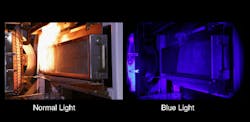Narrowband blue illumination and matched optical filter allow seeing through fire
Seeing through bright flames is normally difficult, as fire emits its own light. But researchers at the National Institute of Standards and Technology (NIST; Gaithersburg, MD) and Berkshire Hathaway Specialty Insurance (Boston, MA) have come up with a way to see through flames: use a combination of narrowband blue (450 nm wavelength) LED illumination and a matched optical filter.1 The amount of narrowband blue light needed is a factor of 104 less than what would be needed if white light were used; for example, a natural-gas fire with a 1 MW power can be seen through using a mere 200 W of blue light.
The new technique can help fire researchers when they perform optical metrology. The method provides detailed information to researchers using optical analysis such as digital image correlation (DIC), a technique that compares successive images of an object as it deforms under the influence of applied forces such as strain or heat. By precisely measuring the movement of individual pixels from one image to the next, scientists gain insight about how the material responds over time, including behaviors such as strain, displacement, deformation, and the microscopic beginnings of failure.
Because fire is a light source with its power generally spread over a large spectral band, the use of a narrowband illumination source and matched optical filter only has to contend with the relatively small optical power of the fire within the chosen narrow spectral band. In addition, to combat image distortion induced by the flames, the researchers averaged a number of single images together.
This video compares two different views of a laboratory fire spread test, one in normal light and the other with NIST's narrow-spectrum illumination system that uses ordinary blue light to see through the flames. In this example, blue-light imaging allows researchers to observe, track and measure the charring of the wood sample. (Shot by J. Gales/York University and edited by D. Sawyer/NIST)
The technique works for clean-burning flames. "Fire makes imaging in the visible spectrum difficult in three ways, with the signal being totally blocked by soot and smoke, obscured by the intensity of the light emitted by the flames, and distorted by the thermal gradients in the hot air that bend, or refract, light," say Matt Hoehler, a research structural engineer at NIST's National Fire Research Laboratory (NFRL). "Because we often use low-soot, non-smoky gas fires in our tests, we only had to overcome the problems of brightness and distortion."
Hoehler also has been involved in the development of a second method for imaging objects through fire with colleagues at NIST's Boulder, Colorado, laboratories. In an upcoming NIST paper in the journal Optica, the researchers demonstrate a laser detection and ranging (LADAR) system for measuring volume change and movement of 3D objects melting in flames, even though moderate amounts of soot and smoke.
REFERENCE:
1. Christopher M. Smith annd Matthew S. Hoehler, Fire Technology (2018); https://doi.org/10.1007/s10694-018-0756-5

John Wallace | Senior Technical Editor (1998-2022)
John Wallace was with Laser Focus World for nearly 25 years, retiring in late June 2022. He obtained a bachelor's degree in mechanical engineering and physics at Rutgers University and a master's in optical engineering at the University of Rochester. Before becoming an editor, John worked as an engineer at RCA, Exxon, Eastman Kodak, and GCA Corporation.
